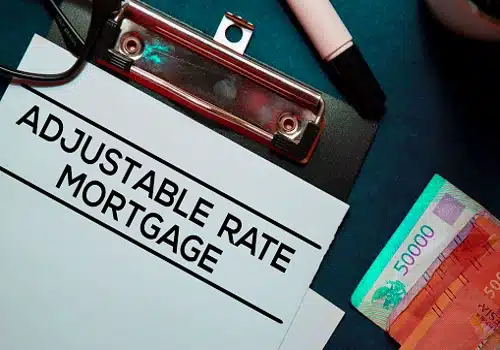As a homeowner, there are always decisions and information to consider when making home loan decisions. While you likely already understand some basics about adjustable rate mortgages (ARM), let’s dig deeper to see why they should be considered as a home loan option.
An adjustable-rate mortgage (ARM) can be an attractive choice for financially astute homeowners who value flexibility with regard to interest rate adjustments. This comprehensive guide will explain its components and offer information to help you decide whether this type of loan suits you and provide insight on navigating the process. So if you’re ready to tackle the question, “How do adjustable rate mortgages work?” let’s dive in together!
What is an adjustable-rate mortgage (ARM)?
An adjustable-rate mortgage (ARM) is a loan whose interest rate fluctuates with market interest rate fluctuations. ARMs provide homeowners with lower initial payments compared to fixed-rate loans while keeping in mind that their rate could increase after an agreed-upon period has elapsed. An ARM offers many potential buyers lower initial rates; however, it may only be suitable for some due to the potential for increased payments over time.
Future homeowners considering an adjustable-rate mortgage (ARM) should carefully weigh all potential risks and benefits before making their final decision. Although ARM loans can provide short-term financial advantages, it is still wise to assess personal financial situations and long-term goals before making decisions regarding mortgage types.
Benefits of an Adjustable Rate Mortgage (ARM)
An adjustable-rate mortgage (ARM) is a loan with an interest rate that fluctuates with market rates; your payments may decrease as rates decline or increase as rates go up. So what are its advantages?
One key benefit for those with adjustable rate mortgages (ARMs) is lower monthly payments, thanks to their index-based rate structure. When mortgage rates decline, monthly payments could potentially decrease, giving borrowers more financial flexibility. Furthermore, initial low rates may entice more people to consider ARMs even while mindful of their potential risks.
Adjusted rate mortgages (ARMs) also carry risks. Their contracts contain clauses such as reset points and caps—measures of when interest rate adjustments occur and how high those adjustments may go—that can create unpredictable payments, which make budgeting challenging when rates rapidly increase after initially low rates expire. Individuals needing these loans may need to set aside funds in case payments unexpectedly increase in the future.
Overall, many have found adjustable-rate mortgages beneficial as long as they fit within their financial plans and they carefully weigh out the risks and rewards involved with an ARM loan. Although people are aware of the potential risks associated with an ARM loan, they remain drawn in by its short-term advantages, such as lower upfront payments. It is always essential to conduct extensive research before making your final decision regarding an adjustable-rate mortgage, as it could make or break your financial future.
How Does an Adjustable Rate Mortgage (ARM) Work?
An adjustable-rate mortgage (ARM) offers more flexibility to borrowers by providing payments that fluctuate throughout their lifecycle, usually after five, seven, or ten years. After the fixed period expires, interest rates fluctuate according to an index such as SOFR (Secured Overnight Financing Rate) or COFI (Cost of Funds Index) before being adjusted periodically according to market conditions.
Proponents of adjustable rate mortgages (ARMs) contend that these products can greatly benefit homeowners looking for lower interest rates in the long run. Should current mortgage rates fall below their initial starting rate on an ARM loan, borrowers could see their monthly cash flow increase due to reduced payments. They could also opt for more stability by refinancing into a fixed-rate mortgage during lower rates. However, there is the risk that mortgage rates will start to increase, making monthly payments higher.
To help you make an informed decision when financing your home, the next section will discuss this topic further so you can make an informed choice.
Application Process
Understanding the adjustable-rate mortgage (ARM) application process is one of the most important parts before being approved for one. When you start your homebuying journey, take your time reading and understanding all terms so there are no surprises down the road. Each lender may differ slightly in their processes and qualifications, but all begin with similar basic steps.
First, borrowers must provide documentation regarding income and assets to the lender. Next, lenders will run a credit report to see if there are any red flags on their score that might pose a risk. Using this data, lenders calculate a debt-to-income ratio (DTI) ratio to confirm whether payments can be afforded without incurring unexpected financial strain. DTI helps determine what loan structure works best for a borrower without adverse side effects that would compromise financial health in other ways.
Once borrowers select a property, real estate agents and loan officers work with borrowers on bidding offers and writing the necessary paperwork to complete sales transactions. Once signed off on by both parties involved in sale negotiations and approved by lenders, closing documents are generated and signed off on.
ARM applications may seem complicated at first, but taking each step seriously will ensure borrowers have all the information needed to select an ARM mortgage type that meets their individual needs and can help stabilize their future finances. Knowledge of adjustable rate mortgages enables customers to navigate them efficiently and confidently, allowing them to acquire or refinance a property safely. Now that you understand how an adjustable rate mortgage works and how to apply for one, it is time to evaluate its advantages and disadvantages as part of a loan structure to ensure you make an informed decision before signing any paperwork.
Credit Guidelines for ARMS
When considering an adjustable-rate mortgage (ARM), familiarize yourself with the credit guidelines set by lenders. Lender requirements often vary and could affect whether you qualify. Borrowers with higher credit scores tend to be eligible for lower rates more easily, so meeting with several lenders and assessing eligibility before applying is recommended.
At first, lenders prefer borrowers with excellent credit histories with no significant delinquencies, which borrowers can demonstrate by making on-time payments for at least one full year before applying for an ARM. Furthermore, lenders prefer those who can document stable employment histories, consistent income streams, and limited consumer debt; it is, therefore, wise to assess your financial status before applying for an ARM, as this can significantly impact whether or not you qualify.
As part of their consideration, lenders also take into account the size of your down payment when lending you money for home ownership. A larger down payment may help secure lower interest rates; for instance, putting 10% down may have higher rates than someone making a 20% down payment; therefore, it is crucial when considering different ARMs to keep this factor in mind when comparing terms across lenders.
Now that you have a better understanding of ARMs, contact Smart Money Inc. to see if this would be a good fit for your situation. We offer expert advice on which loan type you should go with by diving into your long-term financial goals and breaking down quotes and the different requirements each loan type has to help you make an informed decision. Dial (808) 447-1850 to speak with our knowledgeable team and get a comprehensive guide on how adjustable rate mortgages work. Take advantage of potential savings – call us today!



